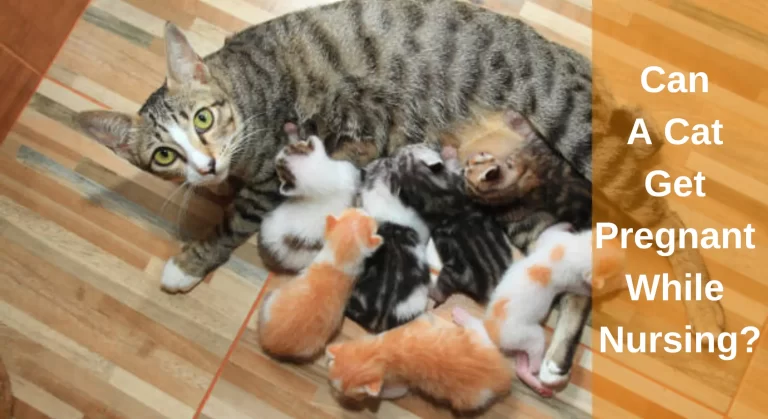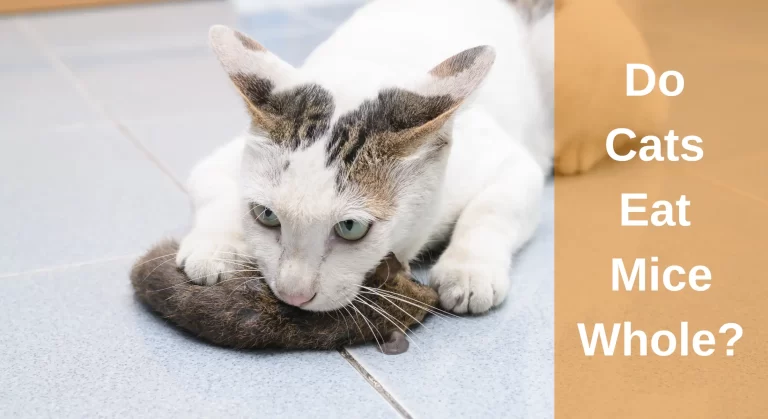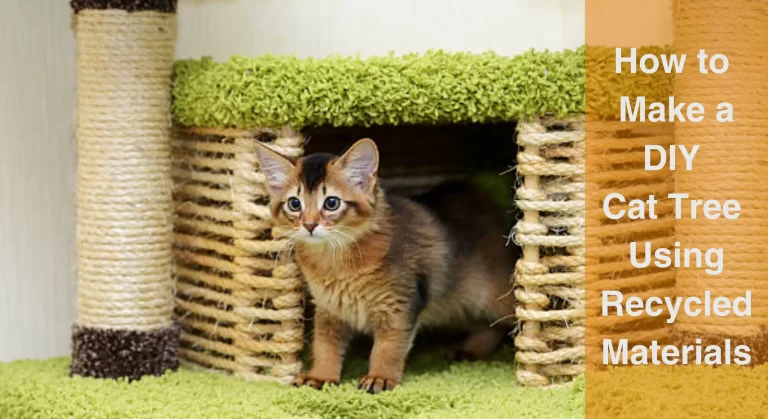Signs of Infection After Neutering Cat: How to Care and Help
Neutering is the most beneficial treatment for your feline. So, have you recently neutered your feline, or thinking to go through this procedure? Then, you undoubtedly have a lot of queries about the recovery process and infection chances. “Signs of Infection After Neutering Cat”
Sadly, 5.8% of felines get infections after having neutering surgery. The signs of infection include liquid accumulation, excruciating pain, bruising, inflammation, excessive heat, and foul odors. If your feline has diarrhea but otherwise seems healthy, is restless, or reduced appetite, the infection may be growing. In this situation, I strongly advise you to take your feline to the vet for proper treatment.
However, it could be challenging for the majority of cat owners to tell the difference between a healing and an infected neutering incision. So, in this article, I’ve discussed infection signs and the difference between a healing wound and an infected one. I’ve also mentioned types of neutering surgeries, how you can avoid infection, and when to call the vet.
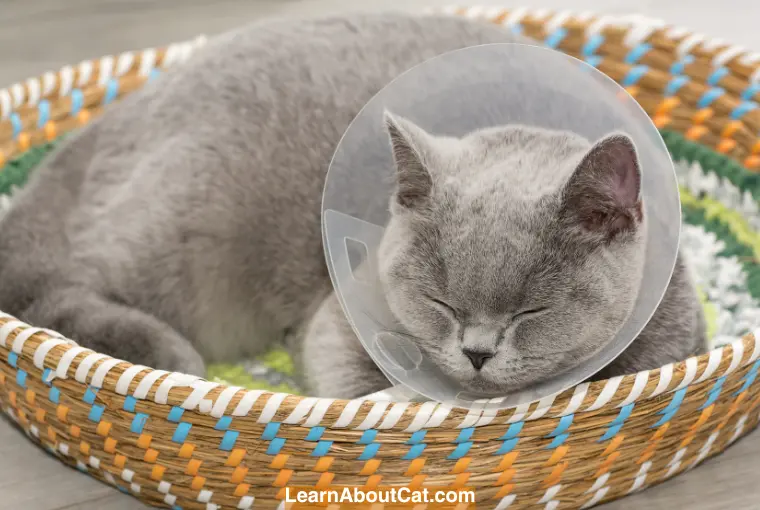
Types of Neutering Incisions in Cats
The surgical wound can be fixed using a variety of techniques, despite the fact that you might believe all neutering wounds are alike. Your vet’s recommendations will determine the kind of cut your cat receives! After neutering/spaying a cat, the veterinarian stitched up the outer layer of skin to cover the cut by following the below 2 methods.
- The obvious staples or incisions at the wound area make this typical closing technique easy to spot. The removal of these stitches could sometimes necessitate a return visit to the veterinarian. The stitches stay in place for about two weeks.
- The other primary technique for fixing neutering wounds involves carefully stitching together every layer of the wound. Multiple layers of the cat’s body are cut while doing a neutering surgery. The diaphragm muscles and subcutis are included in this. As a result, each layer should be intradermal (embedded) stitched to heal properly; according to the advice of your veterinarian.
Your cat’s staples can’t be seen since they will be hidden underneath the skin if your veterinarian chooses to utilize this second technique. Since a solubilized material is used to make the stitches.
So, it dissolves automatically, you don’t have to be concerned about removing them. This lowers the risk of any injuries that occur prior to or during the stitches removing session due to aggression.
Check Out: Can a Neutered Male Cat Still Get a Female Pregnant? All You Need To Know
What Should A Healing Cat Spay Incision Look Like?
Soon after finishing surgery, a normal incision area will look clean and pinkish and both incision margins touch will each other. Stitches might or might not be visible to you.
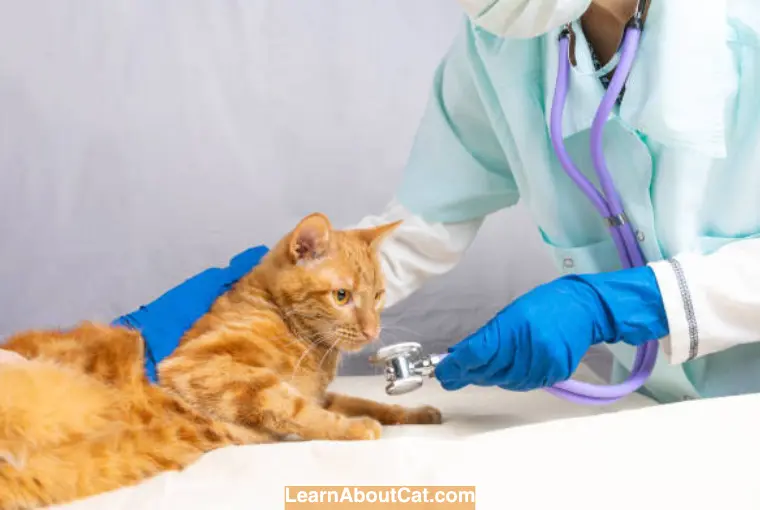
Even though there might be a little fluid seeping after surgery, there shouldn’t be any continuous blood or drainage when you return. For those felines who are particularly active, somewhat inflammation is typical and should be assumed.
As the incisions recover, the skin near and surrounding the cut will look slightly rosy or pinkish. In the weeks after surgery, it’s common for very fair-skinned felines to have apparent scars near the wound area. In both scenarios, after the healing process ends up, the color around your cat’s wound will revert to normal.
Also Read: Cat Lethargic 3 Days After Spay: Is It Normal?
What Does An Infected Incision Look Like?
If bacteria grow in the surgery region during a spay treatment, an inflamed wound is one possible surgical consequence. Your cat may try to lick or claw at the healing wound area if it is a little swollen and irritated during the incision healing time.
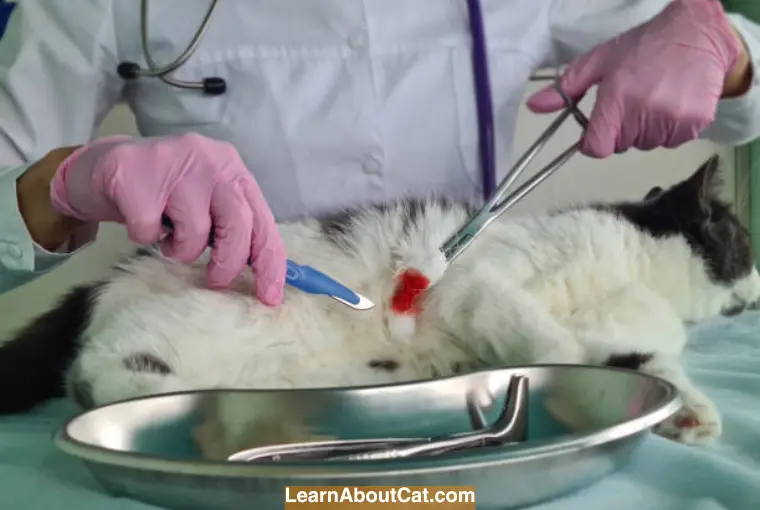
Due to this, infectious agents may transfer from the mouth region to the wound area. If cats are allowed to roam or enjoy before their wounds have fully healed, they risk contracting wound infections.
A neuter incision that is affected will probably be fairly large and red. Additionally, you can see discharge from the region, such as any blood or pus. It’s possible that the wound’s stitches are broken, and you might even see endothelium emerging from it.
Your cat may experience pain with an unhealthy incision. Moreover, it can also prolong recovery and cause the typical 10- to 14-day recovery period for infected cats.
Find Out: Cat Not Eating After Spay: Reasons Cat Owners Should Know
What Are the Signs of Infection After Neutering Cat? Signs of Infection After Spaying Cat
Among the most frequent complications after a neutering surgery is an infection at the site of the wound, particularly within the first week. Keep an eye out for any danger indications at the wound on your feline. Common indications to watch for include:
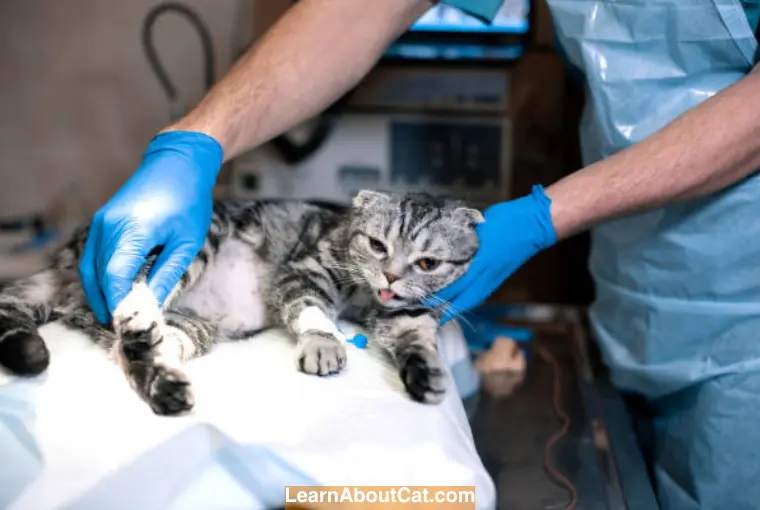
1. Accumulation of Fluid
A seroma is a fluid-filled bubble that develops inside the tissue surrounding the wound. Seromas are frequent in neuter surgeries and can form incidentally as a result of a slight stitch response or when your feline is overactive in the days following surgery.
Even though a seroma isn’t usually unpleasant, it can cause moderate to severe inflammation and leave your cat at risk of becoming infected. If you think that your feline is having a seroma at the incision region, you must take your feline to the vet clinic.
2. Symptoms of Pain
It is typical to experience some pain and soreness following the surgery. Even the neuter scar takes time to heal. A cat may suffer some discomfort near the wound area throughout the healing process, but this will gradually lessen as the wound recovers. I advise giving your cat a pain reliever that has been recommended by a veterinarian if it looks really agitated.
You must begin to worry if your cat exhibits signs of severe discomfort. If you touch the wound area, your cat may sporadically scream and shiver, which indicates it may have an infection. Other typical indicators of discomfort in cats include trembling and trying to hide a lot.
3. Bleeding
If your cat’s incision bleeds a bit, it’s normal and nothing to worry about. During the first 24 hours following surgery, a little quantity of blood leaking is quite typical. When this happens, you must wipe the skin and make it clean, but I strongly encourage you to wait and do it when your vet instructs you to do.
There is a good possibility the wound has grown infections if your cat’s bleeding persists even after 24 hours or gets severe. If you believe your cat’s bleeding is excessive, I recommend calling your veterinarian right away. A separate problem may delay the cut from healing properly even though the incision is not infected.
4. Intense Inflammation
It is typical for the incision area to become a little red or pinkish during the healing process. So, it is normal for its skin to be slightly sensitive and swollen. The body requires the white blood cells to activate in order to support skin binding and regeneration, therefore it’s a sign of normal recovery.
The skin’s color should gradually return to normal as the wound closes. I advise you to get in touch with your vet if your cat’s skin starts to look more discolored. An infestation is frequently indicated when severe redness, or any other obvious coloring, which is abnormal occurs.
5. Unusual Heat
This infection symptom won’t be visible unless you touch the surgical location on your cat. Give as little force as you can while doing this while being very soft to check the skin’s warmth there.
If your feline’s incision is recovering properly, then its warmth will be similar to its body temperature. However, an unusually hot wound should be taken seriously since it might be an infection.
Avoid attempting to resolve this problem on your own because doing so can make it even worse. Therefore, discuss the best way to proceed with your veterinarian.
6. Foul Odor
It’s important to take care of any scents that seem to be emerging from the wound area. There shouldn’t be any odor if your cat’s incision is clear and recovering properly. The presence of an offensive odor, however, indicates an infection.
I advise you to inspect the wound site every day because foul smells mustn’t be detectable if you aren’t fairly close to your cat. You can do this without bringing your face up against the wound. While your cat is sleeping, if you sniff the incision area, you’ll detect any bad smells.
7. Frequent Licking or Clawing Around the Wound
An infection may be present if your feline is constantly licking or clawing the area of the wound. Although it’s common for felines to lick their cuts, prolonged licking can cause more discomfort or even infestation.
The incision may reopen as a result of licking and clawing, which may result in even more severe issues. Bring your feline to the veterinarian right away if you see that their wound is exposed or oozing.
8. Sluggishness or Lack of Hunger
If your feline exhibits signs of fatigue or seems uninterested in eating, this may be one of the symptoms of infection following neutering. If they aren’t eating, dehydration may result, which could exacerbate the condition.
As a result of dehydration your cat’s body becomes heated up and fever may also occur. Monitor your cat’s water consumption and check for signs that they are consuming more often than usual.
What to Do If A Spay Incision Gets Infected?
Even though a wound infection initially seems terrifying, it is treatable with the correct care. Call your vet for advice while keeping a close eye on the wound if you think your cat’s wound isn’t seemed normal.

Your doctor may suggest various therapies based on the seriousness of the ailment. A course of antibiotic treatment should work for mild illnesses. The excision of contaminated tissue and closure surgery may be necessary in more severe cases. In some circumstances, a pipe is inserted in the incision area to drain excess fluid. If septicemia is discovered in your feline, she will need hospitalization and critical care.
The most appropriate approach for your cat includes natural incision care, and it is highly recommended by veterinarians. Never wipe the incision with strong agents such as ethanol or peroxide. Instead, disinfect the area surrounding the incision with fresh, hot water or a disinfecting solution that your vet has recommended.
However, most normal surgery areas don’t need to be cleaned, so ask your vet if this procedure is required. If your cat needs to take medicines, make sure she gets all the doses as directed by your vet.
How Can I Prevent an Infected Incision in Cats?
Fortunately, there are several precautions that will help you to keep the neuter wound hygienic and infection-free. Your vet will give you recommendations that you must follow.
such as keeping your feline from scratching the insertion site and limiting particular activities. Here are some suggestions for preventing an infection incision:
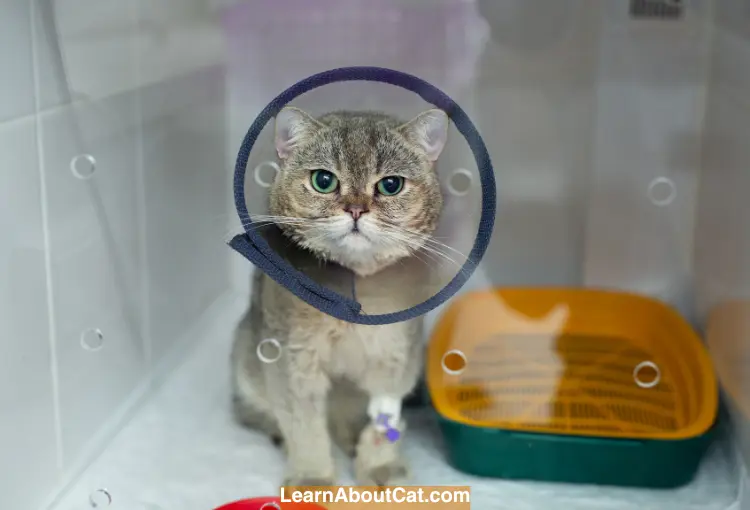
1. Check the Incision area
After the neutering procedure, an important measure you can do is keep a close eye on the wound area of your cat. I advise daily incision inspection to make sure the wound is healing properly.
If you can, count the stitches to make sure you can see any missing ones. Remember to alert your veterinarian to any alarming symptoms.
2. Restriction of Movement
Your cat’s normal daily motions, such as rushing, hopping, and jumping may cause additional stress on the wound.
I advise you to restrict your cat’s activity for the first two weeks of recovery to ensure appropriate recovery. This may require you to confine your feline to a limited space so that you can monitor it more closely.
3. Avoid Bathing Your Pet or Getting the Wound Moist
You can endanger your feline by showering her, letting her bathe in the sink, or providing her access to a warm bath. Moisture not only removes medical glue from the wounded area, but it could also encourage germs that love dampness.
If your vet instructs you to wash your cat’s wound, be careful to completely dry the region to lower the chance of infections.
4. Put on the Elizabeth Collar Regularly
As you’ll notice when felines lick themselves, they can easily reach the majority of their body parts. Cones collars are effective tools to prevent cats from grooming their wound.
Most cats can benefit from a normal plastic cone, although some won’t love wearing one. Some felines will learn and adapt, whereas others may want to get rid of it.
Use a soft cone or an inflated ring if the previous one continues to come off; just make sure that your cat can’t get to the wound area when it’s on.
When to Talk to Your Vet
After neutering treatment, if your feline displays any symptoms of infection, including fever, sluggishness, or decreased appetite, you must contact your veterinarian right away. A dangerous and potentially fatal consequence is infection.
It will be beneficial if you kept an eye out for any inflammation, inflammation, or drainage that would indicate an infection in the wound area.
Quickly get in touch with your doctor if you notice any of the following symptoms. Early action can assist you to stop the illness from growing and speed up your cat’s recovery.
Frequently Asked Questions
Best age to neuter a cat to avoid complications
To avoid any complications during neutering procedures, the best-recommended age of felines by vets is around 4 months. At this age, felines don’t depend on their mothers and are mature for performing the neutering process.
How long does my cat have to wear a cone after neutering?
Most felines continue to wear their cone collar for 5-7 days after having a neutering procedure to prevent grooming the wound. The majority of scrotal wounds heal fastly. If your vet has made an abdominal incision to cut the trapped testicle, then your feline must wear the cone for 10–14 days or until his wound starts healing.
How long does it take for a cat to recover from being neutered?
Your cat’s symptoms will reduce and its hunger will improve in about 24-48 hours, but it’ll require 7 days for a cat to heal quickly after neutering.
Do male cats spray after being neutered?
The cat’s desire to spray will be lessened by neutering because their testes are removed which enhances their desire to do the spraying. Although 10% of neutered males will still spray.
Can cats use the litter box after being neutered?
Yes. But to prevent litter from sticking to the wound for the first 24 hours following surgery, vets frequently advise placing ripped tissue in the feline’s litter box.
Can cats pee normally after being neutered?
After neutering, your felines will urinate and defecate normally. But they won’t pee within 24 hours after neutering, you must call your veterinarian for an examination.
What if my cat is constipated after neuter surgery?
After neutering, constipation is normal in felines. But if your feline hasn’t pooped in 48-72 hours, you must call your vet. It might be due to dehydration and other issues. Cats should not be given enemas, vitamins, or laxatives to avoid constipation.
Wrap Up!
To conclude, neutering has lots of benefits, but still, there are many chances that your feline may develop infections in the incision area. As described above veterinarian uses 2 techniques for the closure of the incision.
But, no matter which procedure is used by your vet, your cat’s incision area still has the potential of being infected. The infection may develop in the form of fl fluid accumulation, excruciating pain, hemorrhage, inflammation, or a foul odor.
If these symptoms aren’t treated, sluggishness, vomiting, and diarrhea may appear which show a growing infection. So, if you detect any signs of infection, I would advise you to call your veterinarian. They can give your cat the care it requires so that the infection can heal up.
Moreover, follow my recommended advice to keep the wound free of infection if your cat isn’t already infected!
Who is Isabella?
My name is Isabella, and I am a dedicated and knowledgeable cat enthusiast. With years of experience caring for cats and a deep love for felines, I made a mission to help other cat lovers navigate the challenges of cat ownership.


